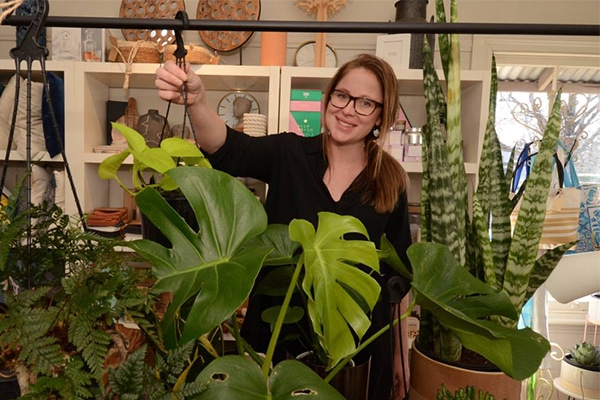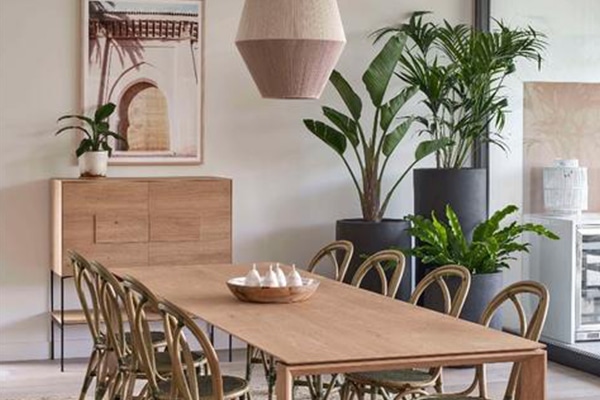THE WORLD HAS CHANGED
In a COVID-19 downturn, sales are more important than ever.
It’s a challenge because less people are out and about and less people are spending their money.
It’s also an opportunity, with people seeking better home office environments (both indoors and out) and using their spare time to improve their homes and gardens.
So, how can your garden centre or nursery turn a potential slump into sales?

1. THINK DIFFERENT
If you want more people to buy from you then ask:
- Why would they choose you? Yes, you!
- Why is your nursery different to all the others that a customer could choose from?
- What makes it unique?
- Why must they go the extra mile to come to you?
If you’re relying on price as your differentiator, there’s always someone cheaper.
If you’re relying on location, someone can always move in next door.
Now is the time to be clear on your point of difference because in a competitive market, it is the clearly differentiated that do best.
So, while you might still choose to sell everything, make sure you specialise in something. For example:
- The succulent specialists
- The place for incredible edibles
- Everything for indoors
- The green well-being store
- The interior designers of the plant world
To work out your specialisation, try this simple exercise:
- Write down the things you do best
- Write down what your customers value most
- Look for where they intersect. This is your differentiator.
Everything you do to promote your nursery should remind your customers that this is what makes you special, and why they should be buying from you.
2. GET YOUR SITE RIGHT
Open your website. Now ask yourself some questions.
First, can you easily find the following pieces of information?
- Your point of difference
- Your address
- Opening hours
- Phone number and email
- What’s in stock
- Links to your other channels e.g. your social media pages, your blog
Second, try opening the website on your mobile.
Is it still easy to read and navigate? Statistics show that more Australians than ever are now accessing websites via their mobile phones, so having a mobile-friendly site is critical.
Third, can I buy from it in just a couple of clicks?
eCommerce was already starting to take over the world, but COVID-19 has made it essential if you want to maximise sales.
If you’re just starting out with this, don’t worry – not everything for sale in store needs to be for sale online. Start with the products you sell the most of, and get comfortable selling those online.
Finally, are you tracking how many people come to your website, where they are coming from, and which pages they go to the most? If not, Google has simple tools to help.
The good news is, you don’t need to spend a lot of time or money to get all these things done. You just need someone with a bit of online confidence and the willingness to spend a couple of days getting it done.
Got all that done? Great. Here are three things that will make it even better:
CHAT: a little window where customers can ask questions and get answers. Engagement is the name of the game.
EVENTS: a list of reasons to put a visit in the diary.
GOOGLE LISTING: Are you listed? If so, does your listing have your opening house, website and phone number? If not, you’re missing out on business, big time.
3. SET UP YOUR SOCIALS
Social isolation is making people more social than ever before, but the party’s on platforms like Facebook and Instagram now – so take this opportunity to grow your online following.
People are increasingly taking to social media to research businesses and products they’re interested in, and join shared-interest communities. Gardening and plants in particular has been trending on social media over the last few years, as established gardeners and budding green thumbs alike look to their social feeds for plant buying information, horticultural advice, and green home styling inspiration.
Social media is also one of the most cost effective forms of marketing, making this a great option for small businesses to reach friends, fans and potential new customers.
The world of social media does move quickly however, and everyone’s at a different stage of the journey, so we’ve outlined ideas for everyone here from beginner to advanced.
This section is broken into three parts:
- Choosing your channel
- Organising your content
- Getting creative
3.1 CHOOSING YOUR CHANNEL
If you’re just starting out, start small. You don’t need to be on every single platform at the same time. Pick one or two that you can really focus on, and sustainably manage, before starting another.
- Facebook – while Facebook remains a great platform for keeping up to date with friends and family, it has also grown to be a place for keeping up to date on news, business offerings and events. It’s a great place to share information about your sales, events, promotions, your team, and give horticultural advice.
- Instagram – designed for the sharing of visual content, i.e. videos and images, this is a platform where many people keep up to date on their interests, passions, and hobbies. It’s also a channel often used for discovery – 90% of users follow a business on Instagram, and 83% report discovering new products or services on the platform.
- YouTube – Great for how-to videos, and as an added bonus, anything you upload to YouTube can be easily also be shared to your Facebook, Instagram and emails, too.
- Email – not a social media channel, but definitely a digital channel worth considering. Email is a great way to connect with people that have already told you they want to hear from you with promotions and announcements.
There are plenty of other digital channels and platforms out there, and there’s always another emerging, like TikTok. To keep up to date with the latest trends, fresh ideas and best practice, bookmark a couple of good blogs such as the Sprout Social blog or the Hootsuite blog.
3.2 ORGANISE YOUR CONTENT
Ok, so now you’re set up – what’s next?
Social media works best if you can post or publish regularly. Why? Because the more people see you on their feed the more familiar they will become with your brand and products.
A simple way to keep on top of your content is to make an easy-to-follow plan that you or your team members can implement.
FIRST: decide out what your overarching content areas are going to be. These are often called ‘content pillars’. For example:
- Gardening how-to’s
- Care tips
- Styling advice
- Sales and promotions
SECOND: plan out specific pieces of content under these areas, and organise logically in a schedule. You can customise the plan to suit your channels and your team, but it should include:
- ‘When’ (time and date),
- ‘Where’ (which platform / channel),
- ‘What’ (pillar, content type, title, subject),
- ‘How much’ – if applicable (ad spend).
GET CREATIVE
This is the fun part! Time to get stuck in and create content to inspire your audience to follow you, and ultimately, buy more from you.
The Plant Life Balance mantra is ‘style with substance’, and for a specific reason. The key to creating engaging content is not just sharing pretty pictures, but the expert know-how, or entertainment factor that goes along with it.
Not sure where to start? Try:
- Plant care tips
- Easy how-to’s and tutorials
- What’s in stock / season
- Upcoming events
- Meet the team
- Impressive plant varieties
- Great gardens you have seen
- The perfect plants for backyards, balconies, windowsills, bathrooms etc
If you’re going to be publishing regularly, consider developing your content in advance and scheduling it for send out later. Facebook and Instagram have scheduling functionalities built in already, but there are many other useful social management tools such Sprout or Hootsuite which can help you organise scheduling across multiple channels.

4. SPEAK THE CUSTOMER’S LANGUAGE
Personal health and wellbeing has always been a big reason for people to buy plants, but right now it is the reason people are buying.
Whatever is in your marketing and messaging, make sure it has a health and wellbeing angle.
Here are a few ideas to get you started:
- Indoor air quality e.g. plants are cleaning the indoor air you are spending so much time in.
- Mental health & stress relief e.g. the calming effects of having plants in your home, at a time a lot of us need help relaxing.
- Productivity e.g. that indoor office can’t be all screen time. Add some green time.
- Learning. e.g. kids learning from home? Green the classroom and watch their concentration grow.
- Exercise e.g. gardening is great exercise, so why not use this time at home to improve your yard?
- Healthy eating e.g. want to eat more vegetables? Then grow your own.
- Family activity e.g. everyone needs ways to keep a healthy family vibe. Plants and gardening are a fantastic family activity for doing so.
Once you’ve chosen your big themes of what you want to focus on, get into the details. People are interested in which plants work well in which room, which clean the air best (hint: check out the NASA study) and they have time to learn – so give them guidance.
Be the expert they are looking for. Now is the time to prove that your nursery is the go-to destination for plant information for creating a healthier, happier home.
5. MAKE BUYING EASY
Time is precious. People were already making the move to time-saving shopping options like home delivery a bigger part of their lives, but now, under COVID-19, it’s the new normal.
Broadly speaking, there are three ways you can save your customers time and make it easy for them to buy.
- Grab & Go
Grab & Go is that shelf of quick grab goodies that sit at the front of stores. Supermarkets are a good example.
Rethink your retail store to have two pathways…one for people who want to take their time, and one for people who want to be in and out.
Grab & Go items should be your higher priced items. After all, convenience comes at a price, right? Also, make sure your Grab & Go items complement each other. Selling a plant? Make sure there’s a pot and some plant food there, too. It’s all about logical combinations in easy to access places.
- Click & Collect
Save time, buy online. Setting up a system that allows your customers to browse and buy from home, then collect at your nursery is another winning formula that mixes eCommerce with real world nursery sales. Make it even easier with a drive through lane so people don’t even need to leave their cars.
We’re predicting drive-through Click & Collect lanes will not go away after COVID-19 – this will continue to be a trend for garden centres moving forward. They’re just too convenient!
- Home Delivery
Hardest for you, but most convenient for your customers. COVID is a good opportunity to try creating a ‘milk run’. Remember, the faster the delivery, the more compelling the offer for your customer, and word will spread fast that people can now buy this way.
6. FRONT UP
COVID might be keeping people out of shops, but they are still in their cars. Once you’ve made your products easy to buy (see 5. Make buying easy), tell everyone by clearly signing your Click & Collect lane and other offers at your store front.
While you’re at it, why not use your street frontage to put up health and wellbeing messages and remind people they can buy online? Street appeal matters.

7. OFFER HOME STYLING
People love to feel special – so why not offer your customers a personalised shopping experience with one of your store’s plant experts? Not only is this a great way to build genuine relationships with your customers, turning them from friendlies into loyal fans – but it’s a fantastic opportunity to engage your staff and show off their expertise.
During COVID-19, many people have more time on their hands and are getting stuck into home jobs, making this the perfect time to offer you could deliver this service via a 15 minute phone or video call, using a platform such as Zoom.
Bring this idea to life by having different staff members specialise in different consultations, e.g. one could be your home styling expert, another could be your specialist vegetable garden builder.
Get your staff (consultants!) to use this dedicated session to understand:
- Your customer’s lifestyle and household arrangement
- Their ability level and capacity to maintain their garden
- Special considerations such as natural light, if they have pets, or kids
- Their aesthetic or stylistic preferences
Once they’re armed with this information, your staff can make personalised – and therefore, highly valuable – recommendations for which plants and products the customer should buy from your nursery. Offer to email the customer a list of these recommendations, and once they confirms, you can process a remote order.
A personalised shopping experience heightens the likelihood that the person will be successful in their gardening efforts, and therefore more likely to become a return customer in the future. Easy for the customer, and easy for you!
8. SELL SUCCESS
We know plants and home gardening are wildly popular at the moment, but there’s a problem – people want success, but some are scared to get started in case they fail.
The good news? Nurseries already have the products on the shelf that will help them. This means there’s a huge opportunity for nurseries to not just sell single products, but bundle together “success kits” that set up customers with everything they need to achieve gardening success at home.
By bundling products together logically, you’re giving your customers both convenience and confidence that they have what they need to keep their gardens thriving.
So, what exactly is in these kits? Create a variety of packs suited to different customers’ households and abilities. For example:
- A STARTER’S SUCCESS KIT including easy to grow plant varieties, soil, pots and pest control products
- VEGGIE GARDEN KIT with vegetable seeds or seedlings, gardening tools and soil improving products
- SMALL SPACE KITS with multiple, smaller plants & pots
- TREE PLANTING KIT with a stake, fertiliser & plant ties
- POLLINATOR KIT with a selection of bee and bird attracting plant varieties for a biodiverse garden
- A ‘LOOKS’ KIT, which groups together plants in curated themes such as easy-care, low light, hanging varieties, native edibles, jungle vibes, and pet-friendly.
The success kit idea works well in combination with the personalised shopping experience (see 7. Offer home styling) – once you know what your customer is after, you can assemble a bespoke kit for them which includes products that will help them to maintain their new garden. Get the look, buy the pack.
9. TAG EVERYTHING
Every plant is a potential sale, so every plant should clearly communicate why it – in particular – should be picked up, purchased and taken home.
Chatting with customers in store or via personal shopping sessions (see 7. Offer home styling) is the perfect opportunity to help them make those smart purchase choices for their home. Beginner or intermediate-level green thumbs in particular will need a bit of an extra hand understanding which plant to buy, and why that’s a good choice for them and their home.
However, you won’t always have the chance to chat with each and every customer. That’s where tags come in – tags are a great way to share the essential information about each plant in a clear and compelling way.
We’re not talking here about the tag(s) that you will already have on each plant showing what it is, and how much it costs – rather, we’re suggesting an additional small tag that communicates a compelling snippet about that plant, for example:

If you wanted to take the concept further for a promotion, for example, a ‘Plant of the week’, create a template that includes:

They’re simple measures to point people in the right direction, but go a long way in making sure your customers are able to make confident, informed decisions on which plant to buy for their home.
And remember – sustainable is best! Talk to your label supplier for reusable, recyclable or sustainable plant labelling options once you’re ready to hit print.
10. ‘MAKE AND TAKE’ BECOMES ‘TAKE AND MAKE’
Plant Life Balance is all about living your life in green – whether that’s about eating, drinking, socialising, learning, or being entertained. Events are a great way to bring this philosophy into your store.
You don’t have to be an expert event planner to put on a great, valuable event for your customers. We know that people are longing for community – by creating a casual environment where people can make friends, discover local artists or experts, or feel like they’ve learnt something, you open a space for them to grow personally not only as gardeners, but as loyal followers of your business.
Events are also a great way to:
- Showcase your horticultural expertise and experience. Plants need gardening, and not everyone knows how to do it successfully
- Connect on a personal level with your customers
- Entertain and/or educate your customers – events can help you to grow a following and increase customer loyalty
- Understand your customers better – in a relaxed environment, they’re more open to coming to you for advice, whether that’s about purchasing or maintaining plants
- Recommend your products!
The great thing about events is that they’re easy to dial up or down, depending on your team’s capacity, your store space, and your existing connections in the community. And in the time of COVID-19, you can just as easily host an event online as you can in-store.
If you run events in-store, consider a “make and take” model where event attendees make something on the day with you, and take it home. In the time of COVID-19, and online events, you can easily flip this to “take and make” where customers purchase the materials or have them delivered, and follow your online event from the comfort of their own home.
Plants and gardening lend themselves to many different kinds of events, for examples:
- Gardening how-to’s e.g. how to re-pot
- Tutorials on planting a windowsill garden, veggie garden, herb garden
- Plant-based cooking
- Nursery or grower tours and interviews
- Terrarium building
- Building a garden bed or plant hanger
- For more ideas, ask your team! You never know what secret skills you’ll uncover that they could share with your community.

















